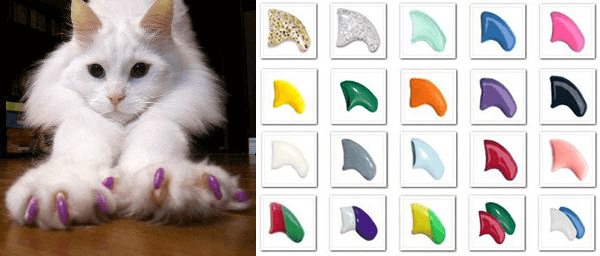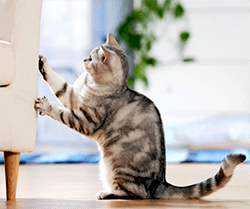What are Nail Caps
The Safe, Painless, Humane Alternative to Declawing
(Read about declawing HERE)
| Call 206-784-3810 to make an appointment to have Soft Paws® applied to your indoor cat's feet. |
Note: Nail caps should only be used on indoor cats because a cat's defenses will be blunted while wearing them. Cats that go outdoors should not wear them.

The Family Pet recommends the Soft Paws® brand which are lightweight vinyl nail shields that are safe, painless, non-toxic caps adhered to your cat's natural nails. The majority of cats need sedation for the application, however once applied, they tolerate Soft Paws extremely well and don't even realize they are wearing them.
Soft Paws® don't "trap" a cat's nail in an extended position. They are designed so that they won't interfere with the natural extension and retraction of cats' claws. Your cat can still stretch and make scratching motions, however no damage will occur to your furniture because the claw is effectively covered and protected. Because the nail cap is thicker than a cat's claw and usually has a color, they are seen more clearly when a cat is resting than the thin end-portion of their claw.
After a month or so, the caps are shed with the natural growth of the cat's nails. Items like Soft Paws® and scratching mats will protect your possessions and provide the necessary outlet for your cat to scratch. Remember, the time you invest in training your cat will be rewarded over a long and happy lifetime together.
Cat Claws
A cat's claws are different from a human's nails. Our nails are flat and lie on top of the tips of our fingers and toes, providing protection for our digits. Cats' claws, by contrast, come out of the front of their toes and act as tools that are used to catch and hold prey, tear meat from bones, defend their bearer, and climb.
Cats usually have five clawed digits on each of their front paws and four on each of their rear paws. However, some cats, known as being polydactyl, may have more. The innermost, shorter claws on the front paws that would be reminiscent of human thumbs are called the dewclaws, and they are useful for cats in holding onto their prey.
Contrary to what many people believe about their cat's claws, they do not retract completely inside a sheath or all the way into the paw. When a cat's claws are in a resting position, they are up off the ground, resting in the fur around the toes. If you look closely at a cat with retracted nails, you can see the nail tips protruding from the fur.
When a cat wants to use his claws, he contracts a tendon to extend them out and down. The extension and retraction of a cat's claws is similar to the way in which a person points their toes and flexes their ankle back.
This ability to retract the claws means that when a cat is walking, the claws aren't touching the ground. This cuts down on wear and tear of the claws and ensures that they retain their sharpness. It also means that cats can walk quite quietly, the better to sneak up on their prey. This is why most cats' rear claws don't require trimming as often; they are worn down more through normal walking.
Cats walk on their toes, and this is known as being digitigrade. In contrast, humans are plantigrade walkers, which mean that the sole of the foot is the walking surface. Because of this, cats that are declawed can have trouble balancing properly.
Cats have claws that curve at the ends. This aids them in catching and holding onto prey and also in climbing. However, it adds to the risk of cats' nails getting stuck in items such as carpet loops and subsequently injuring their toes.
Cats' claws grow continuously, just like human nails. Cats may wear them down through walking or biting at them. The outer sheaths of the claws, which become dull over time, are shed when a cat scratches at things.

Why do cats scratch things?
A cat's natural instinct to scratch serves both physical and psychological needs. Their claws are their primary, instinctive tools for defending themselves and capturing prey.
While dogs urinate to mark their territory, cats have another method of scent-marking. Cats have scent glands in their paws. By using their claws, they mark an area with the scent from their paw glands.
But cats don't use scratching solely as a social cue. Often, they scratch as a way to stretch their bodies and tone their muscles by digging their claws into something and pulling back against their own claw hold. or to condition their claws by removing their old nail sheaths.
